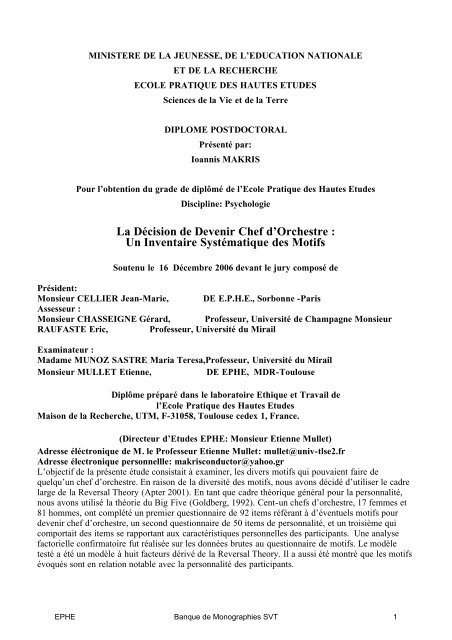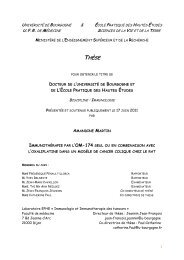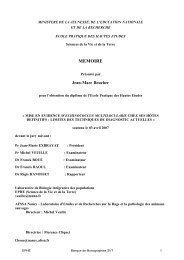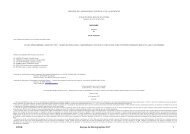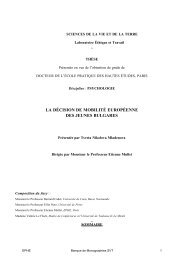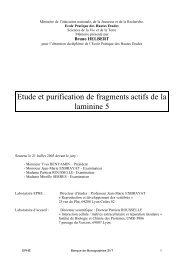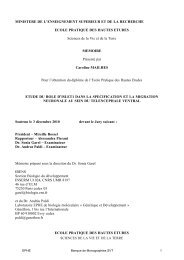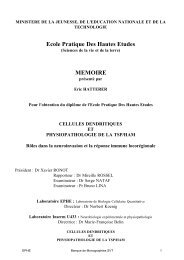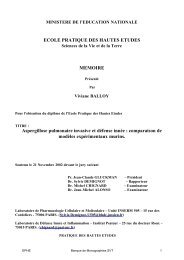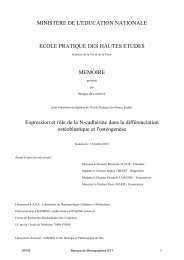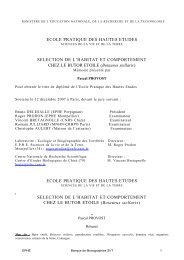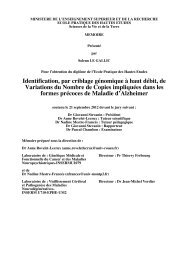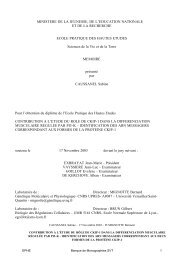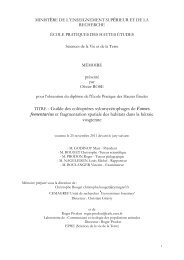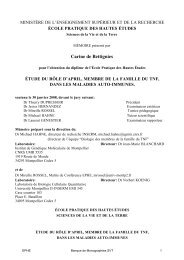La Décision de Devenir Chef d'Orchestre - EPHE
La Décision de Devenir Chef d'Orchestre - EPHE
La Décision de Devenir Chef d'Orchestre - EPHE
Create successful ePaper yourself
Turn your PDF publications into a flip-book with our unique Google optimized e-Paper software.
MINISTERE DE LA JEUNESSE, DE L’EDUCATION NATIONALE<br />
ET DE LA RECHERCHE<br />
ECOLE PRATIQUE DES HAUTES ETUDES<br />
Sciences <strong>de</strong> la Vie et <strong>de</strong> la Terre<br />
DIPLOME POSTDOCTORAL<br />
Présenté par:<br />
Ioannis MAKRIS<br />
Pour l’obtention du gra<strong>de</strong> <strong>de</strong> diplômé <strong>de</strong> l’Ecole Pratique <strong>de</strong>s Hautes Etu<strong>de</strong>s<br />
Discipline: Psychologie<br />
<strong>La</strong> <strong>Décision</strong> <strong>de</strong> <strong>Devenir</strong> <strong>Chef</strong> d’Orchestre :<br />
Un Inventaire Systématique <strong>de</strong>s Motifs<br />
Soutenu le 16 Décembre 2006 <strong>de</strong>vant le jury composé <strong>de</strong><br />
Prési<strong>de</strong>nt:<br />
Monsieur CELLIER Jean-Marie, DE E.P.H.E., Sorbonne -Paris<br />
Assesseur :<br />
Monsieur CHASSEIGNE Gérard, Professeur, Université <strong>de</strong> Champagne Monsieur<br />
RAUFASTE Eric, Professeur, Université du Mirail<br />
Examinateur :<br />
Madame MUNOZ SASTRE Maria Teresa,Professeur, Université du Mirail<br />
Monsieur MULLET Etienne, DE <strong>EPHE</strong>, MDR-Toulouse<br />
Diplôme préparé dans le laboratoire Ethique et Travail <strong>de</strong><br />
l’Ecole Pratique <strong>de</strong>s Hautes Etu<strong>de</strong>s<br />
Maison <strong>de</strong> la Recherche, UTM, F-31058, Toulouse ce<strong>de</strong>x 1, France.<br />
(Directeur d’Etu<strong>de</strong>s <strong>EPHE</strong>: Monsieur Etienne Mullet)<br />
Adresse éléctronique <strong>de</strong> M. le Professeur Etienne Mullet: mullet@univ-tlse2.fr<br />
Adresse électronique personnellle: makrisconductor@yahoo.gr<br />
L’objectif <strong>de</strong> la présente étu<strong>de</strong> consistait à examiner, les divers motifs qui pouvaient faire <strong>de</strong><br />
quelqu’un chef d’orchestre. En raison <strong>de</strong> la diversité <strong>de</strong>s motifs, nous avons décidé d’utiliser le cadre<br />
large <strong>de</strong> la Reversal Theory (Apter 2001). En tant que cadre théorique général pour la personnalité,<br />
nous avons utilisé la théorie du Big Five (Goldberg, 1992). Cent-un chefs d’orchestre, 17 femmes et<br />
81 hommes, ont complété un premier questionnaire <strong>de</strong> 92 items référant à d’éventuels motifs pour<br />
<strong>de</strong>venir chef d’orchestre, un second questionnaire <strong>de</strong> 50 items <strong>de</strong> personnalité, et un troisième qui<br />
comportait <strong>de</strong>s items se rapportant aux caractéristiques personnelles <strong>de</strong>s participants. Une analyse<br />
factorielle confirmatoire fut réalisée sur les données brutes au questionnaire <strong>de</strong> motifs. Le modèle<br />
testé a été un modèle à huit facteurs dérivé <strong>de</strong> la Reversal Theory. Il a aussi été montré que les motifs<br />
évoqués sont en relation notable avec la personnalité <strong>de</strong>s participants.<br />
<strong>EPHE</strong> Banque <strong>de</strong> Monographies SVT 1
THE DECISION TO BECOME AN ORCHESTRA CONDUCTOR:<br />
A SYSTEMATIC INVENTORY OF MOTIVES<br />
The present study aimed at examining, the various motives that may lead an individual to<br />
becoming a classic orchestra conductor. In view of the diversity of potential motives, it was<br />
<strong>de</strong>ci<strong>de</strong>d to use the broad framework offered by the Reversal Theory (Apter). The theoretical<br />
framework for the examination of personality was based on the Big Five Theory (Goldberg, 1992).<br />
One hundred and one conductors (17 females and 81 males, 50 of them Greeks first filled in a<br />
questionnaire composed of 92 items referring to possible motives one may have for becoming an<br />
orchestra conductor. The same sample then filled in a 50-item questionnaire which <strong>de</strong>alt with<br />
personality matters and then filled a third questionnaire with questions salient to the personal<br />
characteristics of the participants. A confirmatory factor analysis was conducted on the raw data as<br />
that <strong>de</strong>rived from the Reversal Theory. The mo<strong>de</strong>l tested was correlated on the eight-factor mo<strong>de</strong>l.<br />
It was proven that much of what participants claimed in their answers was largely based on their<br />
personal characteristics.<br />
Discipline: Psychologie<br />
Mots clés: Musique, théorie <strong>de</strong> renversement, motif, chef d’orchestre.<br />
<strong>La</strong>boratoire Ethique et Travail <strong>de</strong> l’Ecole Pratique <strong>de</strong>s Hautes Etu<strong>de</strong>s, Maison <strong>de</strong> la Recherche,<br />
UTM, F-31058, Toulouse ce<strong>de</strong>x 1, France.<br />
Sommaire<br />
Remerciements…………………………………………………………… 3<br />
Sommaire……………………………………………………………………. 4<br />
Introduction………………………………………………………………….. 5<br />
Métho<strong>de</strong>………………………………………………………………………. 44<br />
Résultats……………………………………………………………………… 47<br />
<strong>EPHE</strong> Banque <strong>de</strong> Monographies SVT 2
Discussion……………………………………………………………………... 61<br />
Références…………………………………………………………………….. 69<br />
Annexes………………………………………………………………………. 79<br />
Introduction<br />
L’objectif <strong>de</strong> la présente étu<strong>de</strong> était d’examiner, en nous appuyant sur un cadre théorique<br />
actuel et précis (la théorie du renversement <strong>de</strong> Apter et la théorie <strong>de</strong>s cinq facteurs <strong>de</strong> la<br />
personnalité - Big Five Factor -), les divers motifs (raisons) qui pouvaient faire quelqu’un déci<strong>de</strong><br />
<strong>de</strong> <strong>de</strong>venir un chef d’orchestre. L’objectif était également d’examiner les relations existant entre ces<br />
motifs et les facteurs <strong>de</strong> base <strong>de</strong> la personnalité.<br />
Références bibliographiques<br />
Apter, M. J. (1982). The experience of motivation: The theory of psychological reversals. New<br />
York: Aca<strong>de</strong>mic Press.<br />
Apter, M. J. (1989). Reversal Theory: Motivation, emotion and personality. London: Routledge.<br />
Apter, M. J. (2001) (Ed.). Motivational styles in everyday life: A gui<strong>de</strong> to Reversal Theory.<br />
Washington, DC: American Psychological Association.<br />
Apter, M. J. & Batler, R. (1997). Gratuitous risk: A study of parachuting. In S. Svebak & M. J.<br />
Apter (Eds.), Stress and health: A reversal theory perspective (pp. 119-129). Washington D.C.:<br />
Taylor & Francis.<br />
<strong>EPHE</strong> Banque <strong>de</strong> Monographies SVT 3
Bechne, K.-E. (1997). The <strong>de</strong>velopment of Musikerleben in adolescence: How and why children<br />
listen to music (pp. 143-159). In, I. Deliège, & J. A. Sloboda (Eds.), Perception and cognition of<br />
music. Hove, UK: Psychology Press.<br />
Boal-Palheiros, G. M., & Hargreaves, D. J (2001). Listening to music at home and at school.<br />
British Journal of Music Education, 18, 103-118.<br />
Bower, G.H. (1992). How might emotions affect learning? In The handbook of emotion and<br />
memory: research and theory, (ed. S-A. Christianson), pp. 3-31. Hillsdale, NJ: Erlbaum.<br />
Brand, M. (201). Chinese and American music majors: Cross-cultural comparisons in motivation<br />
and strategies for learning and studying. Psychology of Music, 29, 170-178.<br />
Clarke, E.F. (1988). Generative principles in music performance. In Generative principles in<br />
music. The psychology of performance, improvisation, and composition, (ed. J.A.Sloboda), pp. 1-26.<br />
Oxford, U.K: Clarendon Press.<br />
Clynes, M. (1989). Sentics: The touch of emotions. Bridport, UK: Prism Press.<br />
Costa, P. T., & McCrae, R. R. (1992). Revised NEO Personality Inventory (Neo-PI-R) and NEO<br />
Five-Factor Inventory (NEO-FFI): Professional manual. O<strong>de</strong>ssa, Florida: Psychological Assessment<br />
Resources.<br />
Cottencin, A., Mullet, E., & Sorum, P. (2006). Consulting an alternative practitioner: A systematic<br />
inventory of motives. Journal of Alternative and Complementary Medicine.<br />
Davidson, J.W., Sloboda, J.A., Moore, D.G. and Howe, M.J.A. (1996). Characteristics of music<br />
teachers and the progress of young instrumentalists. Journal of Research in Music Education, 46.1,<br />
141-160.<br />
Diaz <strong>de</strong> Chumaceiro, C. L. (2004). Serendipity and pseudoserendipity in career paths of successful<br />
women: Orchestra conductors. Creativity Research Journal, 16, 345-356.<br />
Digman, J. M. (1996). The Curious History of the Five-Factor Mo<strong>de</strong>l. In J.S. Wiggins (Eds.),<br />
The Five-Factor Mo<strong>de</strong>l of Personality: Theoretical Perspective (pp. 1-20). Guilford Press.<br />
Gabrielsson, A. & Juslin, P.N. (1996). Emotional expression in music performance: between the<br />
performer’s intention and the listener’s experience. Psychology of Music, 24, 68-91.<br />
Friberg, A. (1991). Generative rules for music performance: a formal <strong>de</strong>scription of a rule system.<br />
Computer Music Journal, 15, 56-71.<br />
Gabrielsson, A. (2001). Emotions in strong experiences with music. In p.n. Juslin, 7 J.A.<br />
Sloboda(Eds.), Music and Emotion: Theory and Research. New York: Oxford University Press, 431-<br />
449.<br />
Gagne, F. (1999). Nature or nurture? A re-examination of Sloboda and Howe’s (1991) interview<br />
study on talent <strong>de</strong>velopment in music. Psychology of Music, 27, 38-51.<br />
Gallup, G., Jr., & Castelli, J. (1989). The people’s religion. New York: Macmillan.<br />
Girau<strong>de</strong>au, C., Chasseigne, G, Apter, M. J., & Mullet, E. (2006). Adult’s lay views about<br />
intelligence : A Reversal Theory approach. Personality and Individual Differences.<br />
<strong>EPHE</strong> Banque <strong>de</strong> Monographies SVT 4
Goldberg, L. R. (1992). The <strong>de</strong>velopment of markers of the Big-Five factor structure.<br />
Psychological Assessment, 4, 26-42.<br />
Goldberg, L. R. (1999). A broad-bandwidth, public-domain, personality inventory measuring the<br />
lower-level facets of several Five-Factor mo<strong>de</strong>ls. In I. Merviel<strong>de</strong>, I. Deary, F., De Fruyt, and F.<br />
Ostendorf (Eds.), Personality Psychology in Europe (Vol. 7, pp. 7-28). Tilburg, The Netherlands:<br />
Tilburg University Press.<br />
Haroutounian, J. (1995). Talent i<strong>de</strong>ntification and <strong>de</strong>velopment in the arts: An artistic/ educational<br />
dialogue. Roeper Review, 18, 112-17<br />
Hergraves D.J., North A.C.(Eds). (1997). The social psychology of music. Oxford, U.K.: Oxford<br />
University Press.<br />
Hergraves D.J., North A.C., (1999). The functions in every day life: Re<strong>de</strong>fining the social in<br />
Music Psychology. Psychology of Music, 27, 71-83.<br />
Holbrook, M. & Anand, P. (1990). Effects of tempo and situtional arousal on the listener’s<br />
perceptual and affective responces to music. Psychology of Music, 18, 150-62.<br />
Howe, M.J.A., Davidson, J.W., Moore, D.G and Sloboda, J.A. (1995). Are there early childhood<br />
signs of musical ability? Psychology of Music, 23, 162-176.<br />
Juslin, P. N. (1997). Emotional communication in music performance: Afunctionalist perspective<br />
and some data. Music Perception, 14, 383-418.<br />
Juslin, P. N.(2000). Cue utilization in communication of emotion in music performance: Relating<br />
performance to perception. Journal of Experimental Psychology: Human Perception and<br />
Performance, 26, 1797-813.<br />
Juslin, P. N., & <strong>La</strong>ukha, P. (2004). Expression, perception, and induction of musical emotions: A<br />
review and a questionnaire study of everyday listening. Journal of New Music Research, 33, 217-238.<br />
Kamiya, J. (1990) Operant control of the EEG alpha rhythm and some of its reported effects on<br />
consciousness. In Altered states of consciousness, (3rd edn) (ed. C.T.Tart), pp. 600-11. San Fransisco,<br />
CA: Harper.<br />
Kenealy, P.(1988). Validation of a music mood induction procedure: Some preliminary findings.<br />
Cognition and Emotion 2, 41-8.<br />
Kelly, G.A.(1963). A theory of personality. The psychology of personal constructs. New York:<br />
W.W. Norton & Co.<br />
Kerr, J.H., Kawaguchi, C., Oiwa, M., Terayama, Y., & Zukawa, A. (2000) Stress, anxiety and<br />
other emotions in Japanese mo<strong>de</strong>rn dance performance. Pacific Journal of Psychology, 11, 1, 16-33.<br />
Konecni, V.J.(1982). Social interaction and musical preference. In D. Deutsch (Ed.). The<br />
psychology of music. San Diego, CA: Aca<strong>de</strong>mic Press.<br />
<strong>La</strong>khdar, M, Vinsonneau, G., Apter, M. J., & Mullet, E. (2006). Conversion in Islam among<br />
<strong>EPHE</strong> Banque <strong>de</strong> Monographies SVT 5
French adolescents and adults: A systematic inventory of motives. International Journal of<br />
Psychology of Religion.<br />
<strong>La</strong>mont, A., Hargreaves, D. J., Marshall, N. A., & Tarrant, M. (2003). Young people’s music in<br />
and out of school. British Journal of Music Education, 20, 229-241.<br />
Lehmann, A.C. (1997). Acquired mental representations in music performance: Anecdotal and<br />
preliminary empirical evi<strong>de</strong>nce. In Does practice make perfect? Current theory and research on<br />
instrumental music practice, (es. H. Jorgensen & A.C.Lehmann), pp. 141-63. Oslo, Norway:<br />
Norwegien State Aca<strong>de</strong>my of Music.<br />
Merriam, A.P. (1964). The anthropology of music. Chicago: Northwestern University Press.<br />
Meyer, L.B. (1956). Emotion and meaning in music. Chicago: University of Chicago Press.<br />
Neill, S. L. (1998). Motivating factors for stu<strong>de</strong>nts participation in high school choral programs<br />
and vocal enrichment activities. Dissertation Abstracts International Section A: Humanities and Social<br />
Sciences, 59, p. 1105.<br />
North,A.C., Hargreaves, D.J. and O’Neill, S.A. (200). The importance of music to adolescents.<br />
British Journal of Educational Psychology, 70, 255-272.<br />
North,A.C., Hargreaves, D.J.(1997a). Experimental aesthetics in everyday life. In D.J.Hargreaves<br />
& A.C. North (Eds), The social psychology of music (pp.84-103). Oxford, UK: Oxford University<br />
Press.<br />
North,A.C., Hargreaves, D.J.(1999). Can music move people? The effects of musical complexity<br />
and silence on waiting time. Environment and behavior, Vol.31, No.1, January 1999, 136-149<br />
Ohgushi ,K. & Senju, M. (1987). How are the player’s i<strong>de</strong>as conveyed to the audience? Music<br />
Perception, 4, 311-24.<br />
Parker, G. B., & Brown, L.B. (1982). Coping behaviors that mediate between life events and<br />
<strong>de</strong>pression. Archives of General Psychiatry, 39, 1386-1391.<br />
Parncutt, P., Sloboda, J.A., & Clarke, E.F.(1997). Inter<strong>de</strong>pendance of right and left hands in sightread,<br />
written, and rehearsed fingerings of piano music in parallel octaves. In Proceedings of the Third<br />
Triennial ESCOM Conference, (ed. A. Gabrielsson), pp. 702-5. Uppsala, Swe<strong>de</strong>n: Department of<br />
Psychology, Uppsala University.<br />
Persson, R. S. (1993). The subjectivity of musical performance: An exploratory musicpsychological<br />
real world enquiry into the <strong>de</strong>terminants and education of musical reality. Unpublished<br />
dissertation, School of Human and Health sciences, Hud<strong>de</strong>rsfield University.<br />
Persson, R. S. (1995). Musical reality: Exploring the subjective word of performers. In Song and<br />
signification. Studies in music semiotics, (ed. R. Monelle & C.T. Gray), pp. 58-63. Edinburgh, UK:<br />
Faculty of Music, University of Edinburgh.<br />
Person, R.S., Pratt.g., & Robson,C.(1996). Motivational and influential components of musical<br />
performance: A qualitative analysis. In Fostering the growth of high ability: European perspectives,<br />
<strong>EPHE</strong> Banque <strong>de</strong> Monographies SVT 6
(ed. A.J.Cropley & D. Dehn), pp.287-301. Norwood NJ:Ablex.<br />
Persson, R. S. (2001). The subjective world of the performer (pp. 275-289). In, P. N. Juslin, & J.<br />
A. Sloboda (Eds.), Music and emotion: Research and Practice. Oxford: Oxford University Press.<br />
Rapoport, E. (1996). Emotional expression co<strong>de</strong> in opera and lied singing. Journal of New Music<br />
Research, 25, 109-49.<br />
Rigg, M.G. (1940). Speed as a <strong>de</strong>termination of musical mood. Journal of Experimental<br />
Psychology, 27, 566-71.<br />
Rippere, V.(1977)What’s the thing to do when you’re feeling <strong>de</strong>pressed? – A pilot study. Behavior<br />
Research and therapy, 15, 185-191.<br />
Roe, K. (1985). Swedish youth and music: Listening patterns and motivations. Communication<br />
Research, 12, 353-362.<br />
Robert, E., Thayer, J., Robert, N., and Tracey, M.McC. (1994). Self – regulation of Mood:<br />
Strategies for changing a Bad Mood, Raising Energy, and Reducing Tension. Journal of personality<br />
and Social Psychology, Vol. 67, No5, 910-925.<br />
Saucier, G., & Goldberg, L. R. (2002). Assessing the Big Five: applications of 10 psychometric<br />
criteria to the <strong>de</strong>velopment of marker scales. In B. De Raad, & M. Perugini (Eds.), Big Five<br />
Assessment (pp. 29-58). Hogrefe and Huber Publishers.<br />
Saucier, G., & Ostendorf, F. (1999). Hierarchical sub-components of the Big-Five personality<br />
factors: A cross-language replication. Journal of Personality and Social Psychology, 76, 613-627.<br />
Shore, R.E. (1990). Hypnosis and the concept of the general reality of orientation. In altered<br />
states of consciousness, (3rd edn) (ed. C.T.Tart), pp. 281-301, San Fransisco, CA: Harper.<br />
Sloboda, J.A., (1998). Does music mean anything? Musicae Scientiae, 2, 21-32.<br />
Sloboda, J.A. and Howe, M.J.A. (1999). Musical Talent and individual differences in musical<br />
achievement: Areply to Gagné (1999). Psychology of Music, 27, 52-54.<br />
Sloboda, J.A. and Howe, M.J.A. (1991). Biographical precursors of musical excellence: An<br />
interview study. Psychology of Music, 19, 3-21.<br />
Sloboda, J.A., Davidson, J.W., Howe, M.J.A. and Moore, D.G.(1996). The role of practice in the<br />
<strong>de</strong>velopment of expert musical performance. British Journal of Psychology, 87, 287-309.<br />
Stanislavski, C. (1988). An actor prepares. London: Methun Drama. (Originally published in<br />
1937).<br />
Steptoe, A. (2001). Negative emotions in music making: the problem of performance anxiety (pp.<br />
291-308). In P. N. Juslin, & J. A. Sloboda (Eds.), Music and emotion: Research and Practice.<br />
Oxford: Oxford University Press.<br />
Stratton, V. N., & Zalanowski, A. H. (2003). Daily music listening habits in college stu<strong>de</strong>nts:<br />
Related moods and activities. Psychology and Education: An Interdisciplinary Journal, 40, 1-11.<br />
Tarrant, M., North, A. C., & Hargreaves, D. J. (2000). English and American adolescents’ reasons<br />
for listening to music. Psychology of Music, 28, 166-173.<br />
<strong>EPHE</strong> Banque <strong>de</strong> Monographies SVT 7
Thayer,R.E. (1978). Toward a psychological theory of multidimensional activation (arousal).<br />
Motivation and Emotion, 2,1-34.<br />
Thayer, R.E. (1987a). Energy, tiredness and tension effects of a sugar snak vs. mo<strong>de</strong>rate exercise.<br />
Journal of Personality and Social Psychology, 52, 119-125.<br />
Thayer, R.E. (1987b). Problem perception, optimism, and related states as a function of time of<br />
day (diurnal rhythm), and mo<strong>de</strong>rate exercise: Two arousal states in interaction. Motivation and<br />
Emotion, 11, 19-36.<br />
Thayer, R.E. (1989). The biopsychology of mood and arousal. New York: Oxford University<br />
Press.<br />
Thayer, R.E. (1991). Practical short – term strategies for maintaining an optimal mood. In R.E.<br />
Thayer (Chair), Theoretical implications and practical applications of mo<strong>de</strong>rn mood theory.<br />
Symposium conducted at the 99th Annual Convention of the American Psychological Association,<br />
San Francisco.<br />
Thayer, R.E., Peters, D.P. III, Takahashi, P.J., & Birkhead – Flight, A.M. (1993). Mood and<br />
behavior (smoking and sugar snacking) following mo<strong>de</strong>rate exercise: A partial test of self – regulation<br />
theory. Personality and Individual Differences, 14, 97-104.<br />
Thayer, R. E., Newman, J. R., & McClain, T. M. (1994). Self-regulation of mood: Strategies for<br />
changing a bad mood, raising energy, and reducing tension. Journal of Personality and Social<br />
Psychology, 67, 910-925.<br />
Waterman, M. (1996). Emotional responses to music. Implicit and explicit effects in listeners and<br />
performers. Psychology of Music, 24, 53-67.<br />
Watt R.J. & Ash, R.L.(1998). A psychological investigation of meaning in music. Musicae<br />
Scientiae, 2, 33-54.<br />
Wedin, L. (1972). A multidimensional study of the perceptual-emotional qualities in music.<br />
Scandinavian Journal of Psychology, 13, 241-57.<br />
Wells, A, & Hakanen, E. A. (1991). The emotional use of popular music by adolescents.<br />
Journalism Quarterly, 68, 445-454.<br />
Wells, A, Hakanen, E. A., & Tokinoya, H. (2000). The emotional use of popular music by<br />
Japanese adolescents (pp. 174-181). In, S. Waksman (Ed.), Popular music: Intercultural<br />
interpretations. Bowling Green: Bowling Green State University.<br />
<strong>EPHE</strong> Banque <strong>de</strong> Monographies SVT 8


